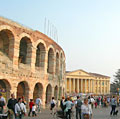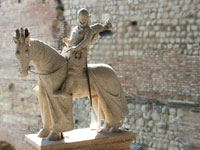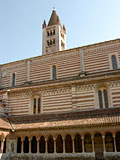Verona
Situated on the banks of the river Adige, Verona is one of Italy’s most beautiful art and historical cities, it is so rich in Roman remains that, after Rome, it is considered to be the city with the most remains from that period. Visitors are surrounded by living history that can be viewed at every turn, from its Romanesque and Renaissance monuments, to its bridges, city gates, historical buildings, streets, and its charming churches and their frescoes.
Verona's main monuments
 Verona is famous for the operas held in its Arena, the setting for the Shakespearian tragedy of Romeo and Juliet, trade fairs, leisure activities, and local restaurants where visitors can enjoy traditional Veronese dishes washed down by the famous local wines. The city centre is a treasure trove of historical monuments, palaces, and churches that can be viewed by simply walking along streets such as the former via Postumia, now Corso Cavour, Corso Portoni Borsari, and Corso Santa Anastasia which lead to the old Roman forum where the modern day piazza Erbe is located.
Verona is famous for the operas held in its Arena, the setting for the Shakespearian tragedy of Romeo and Juliet, trade fairs, leisure activities, and local restaurants where visitors can enjoy traditional Veronese dishes washed down by the famous local wines. The city centre is a treasure trove of historical monuments, palaces, and churches that can be viewed by simply walking along streets such as the former via Postumia, now Corso Cavour, Corso Portoni Borsari, and Corso Santa Anastasia which lead to the old Roman forum where the modern day piazza Erbe is located. In summer, the Arena, in piazza Bra, and the Roman Theatre at the foot of San Pietro hill are filled with the lights and colours of world famous shows, concerts and operas. Verona’s appearance changed significantly during the period when the city was ruled by the Scaligeri, with the addition of the Castelvecchio and the Scaligero bridge, the walls, the Cangrande palace, the Domus Mercatorum in Piazza Erbe, the Scaligere Arches.
In summer, the Arena, in piazza Bra, and the Roman Theatre at the foot of San Pietro hill are filled with the lights and colours of world famous shows, concerts and operas. Verona’s appearance changed significantly during the period when the city was ruled by the Scaligeri, with the addition of the Castelvecchio and the Scaligero bridge, the walls, the Cangrande palace, the Domus Mercatorum in Piazza Erbe, the Scaligere Arches. A walk through the city of Verona The modern day via Mazzini, or via Nova, is the city’s main street, running from Piazza Brà to Piazza Erbe. It is the main shopping street where all the most famous shops and brands are located and has recently been re-paved. To discover the more out of the way streets or squares look for names such as: “vicolo”, “piazzetta”, “corticella”, “corte” that frequently conceal delightful corners where you will be surrounded by history. Arena The Roman amphitheatre, the name “Arena” derives from the sand that was used to cover the floor where the spectacles took place. Constructed in an ellipse, during the first century A.D. in Piazza Brà, it is the third largest amphitheatre in Italy.
 Castelvecchio and the Scaligero Bridge Constructed on the banks of the river Adige on the orders of Cangrande II della Scala in 1354, this residential castle also served as a defence bulwark for the city of Verona, it now houses the city museum.
Castelvecchio and the Scaligero Bridge Constructed on the banks of the river Adige on the orders of Cangrande II della Scala in 1354, this residential castle also served as a defence bulwark for the city of Verona, it now houses the city museum.
Roman Theatre and Archeological Museum The Roman Theatre was built at the end of the first century B.C. at the feet of San Pietro hill, it was used for theatrical performances and religious rites, it remained hidden until it was re-excavated at the beginning of the nineteenth century.
Pietra Bridge This bridge was erected at a natural crossing point over the river Adige. The variety of building materials used lends the bridge a picturesque appearance.
 Juliet’s House Located a short walk from Piazza Erbe in Via Cappello, this the house under whose balcony Romeo is said to have sworn eternal love to his beloved Juliet. The Lamberti tower At 83 metres this is the tallest tower in Verona, it is located in Piazza Erbe and visitors can reach the top by walking up the stairs or taking the lift.
Juliet’s House Located a short walk from Piazza Erbe in Via Cappello, this the house under whose balcony Romeo is said to have sworn eternal love to his beloved Juliet. The Lamberti tower At 83 metres this is the tallest tower in Verona, it is located in Piazza Erbe and visitors can reach the top by walking up the stairs or taking the lift.  Palazzi Scaligeri and the Statue of Dante In the centre of Piazza Dante, known as Verona’s drawing room, stands the pensive statue of Dante Alighieri, which forms the backdrop to Piazza il Palazzo degli Scaligeri.
Palazzi Scaligeri and the Statue of Dante In the centre of Piazza Dante, known as Verona’s drawing room, stands the pensive statue of Dante Alighieri, which forms the backdrop to Piazza il Palazzo degli Scaligeri. Courthouse Staircase in the Old Market This grand gothic staircase was built in the fifteenth century and gets its name because it used to lead to the entrance to the courthouse until 200 years ago.












